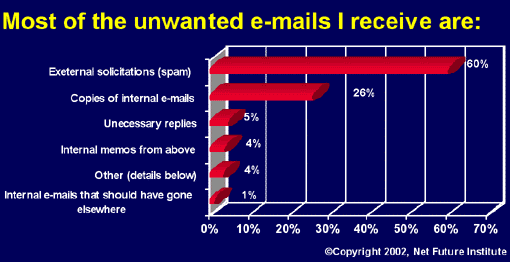E-Mail Behavior

Many managers and workers feel buried in a daily blitz of e-mails, both from inside and outside their organizations. While some feel overwhelmed by this sometimes distracting phenomenon, the proper flow and selective storage of e-mails can help reduce the number of meetings as well as manage daily, weekly and monthly activities
As everyone at work knows, the business world runs on e-mail. Consider these statistics:
– 71 percent of executives and managers that NFI Research surveyed spend one hour or more each day, sending, receiving, reading or writing e-mail.
– More than 25 percent spend three hours or more a day using e-mail.
– 68 percent say that 25 percent or more of the e-mail they get is unnecessary.
– 60 percent of unwanted e-mails are external solicitations (spam), followed by copies of internal e-mails.
E-mail enhances productivity but also creates demands. “Two years ago we processed 25,000 e-mails a day,” says Leo Crawford, chief information officer of Orange County, California, and its 16,000 employees. “Now, we process 800,000 a day. We don’t know why there was such an increase. It just happened.”
On the other side of the country, the story is the same. With a daily volume almost equal to that of Orange County in California, executives in Westchester County, New York, found that e-mail dramatically increased efficiency. “We run on e-mail,” says Norman Jacknis, CIO of Westchester County. “We now have a lot more focus at meetings,” he says, adding that he gets “20,000 e-mails a year.” Jacknis spends up to seven hours a day reading, filing and writing e-mails.
Like the executives in these two counties, businesses face the same daunting challenges presented by the sheer volume of e-mail. So what to do?
Here are 10 rules for taming the e-mail monster.
Organize e-mails into context groups. By categorizing e-mails, such as employee reviews or projects, you end up with a solid, daily to-do list.
Quickly eliminate what doesn’t matter. Kill the junk right away and immediately prioritize the rest.
Read it once, but right away. 94 percent of executives and managers we surveyed around the world said e-mail should be dealt with either immediately or within the first few hours of getting it.
Keep it short. Get to the point, no more than a couple of paragraphs. Businesspeople are buried, just like you. Just write what is necessary.
Avoid e-mail multipliers. Those are communications that do little more than expand exponentially the number of e-mails. Reducing e-mail overload requires monitoring your own e-mail habits and in some cases, showing others how a little thought before hitting the “reply” key can save everyone time. Here are some tips:
Use the subject line as the message itself. If it’s a one-word reply, add it to the original subject line.
Specify “no need to reply.”
Put “DRIB” in the subject line. Stands for “Don’t Read If Busy.” If you must waste people’s time, at least warn them.
Kill the self-perpetuating e-mail, whose biggest category is jokes. A few of these actually can be funny, but senders often do not distinguish and just send all of them to everyone on their mailing e-mail list. Employees sometimes route these to others inside the company, not realizing that e-mail at their company is monitored.
Use e-mail as a filing system. This creates a fail-safe, so nothing falls through the cracks. It also allows you to track areas with the most internal activity based on the number of e-mails on that particular subject.
Return e-mail you should not have received. You might be on “reply all” lists that you were always on. One returned e-mail with a short note saying you don’t need these reduces future inbox growth.
Use as appropriate medium. Great for sending attached spreadsheets, presentations and short notes. Not so good when human interaction (such as relaying very bad news) is required.
Keep assistants in the loop. Assistants make the trains run on time; keep them plugged in.
Use the telephone. E-mail does not solve everything. Sometimes an e-mail is being sent from one cubicle to a cubicle next door, or to a person in an office just across the hall. Sometimes it is more effective to just pick up the phone and call. Or, heaven forbid, get up and go talk to someone. Face-to-face.
Source:
http://www.darwinmag.com/read/110102/emailrules.html

Source:
Plaats reactie
Je moet ingelogd zijn op om een reactie te plaatsen.